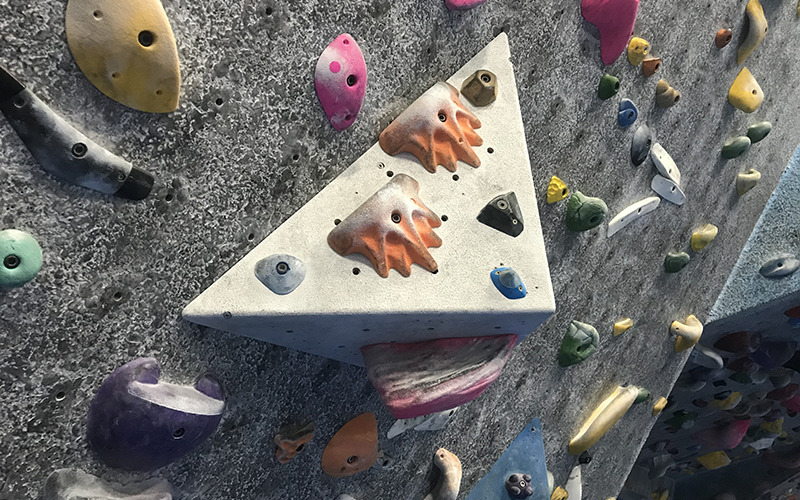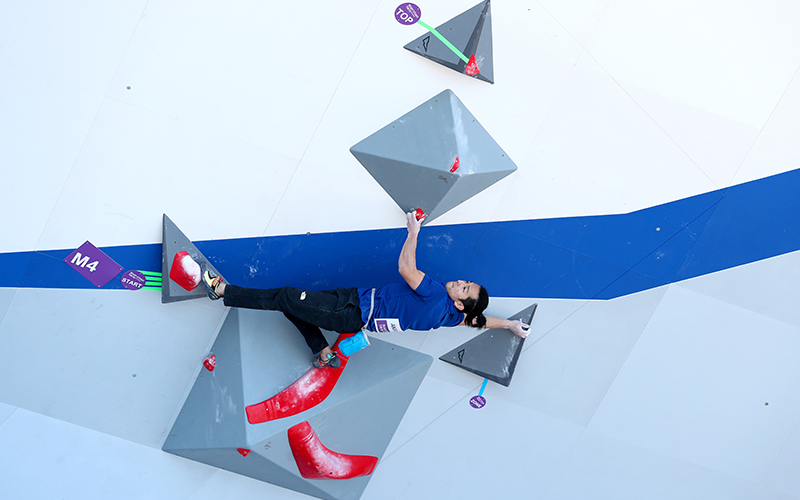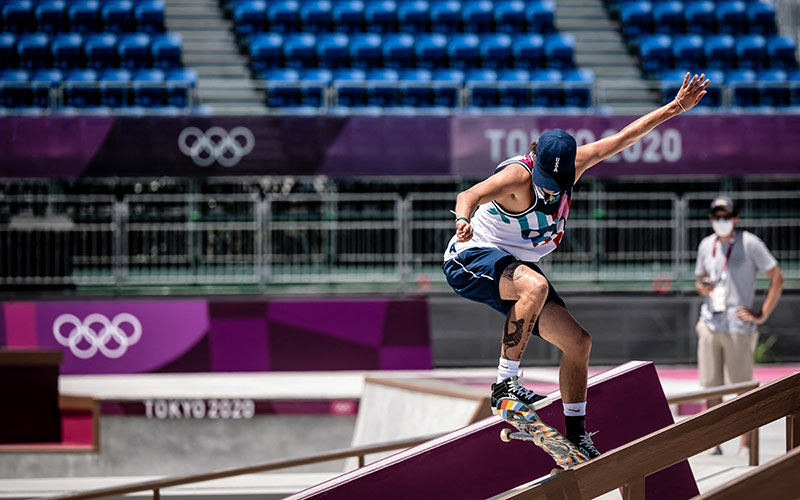TEMPE – Andrew Westerhoff did not know what he was getting into when his sister took him to a climbing gym for the first time. The Arizona State junior started off as an outdoor climber in high school, doing some courses and spending a few weeks climbing in the Rocky Mountains.
Now, after falling in love with sport climbing, there isn’t a day where Westerhoff isn’t at a gym.
When it comes to the Olympics, traditional sports such as gymnastics, swimming, and track and field spring to mind. However, one sport gained enough traction and made its Olympic debut at Tokyo 2020: sport climbing.
With climbing’s increased popularity in recent years, more and more competitive teams are popping up across the nation, including at ASU.
Sun Devil Climbing was founded in 2018 by a group of dedicated climbers. The club aims to promote the sport locally and provide a community of climbers regardless of experience.
With interest from all levels, the club is split into two sections: a recreational club and a competitive team. Recreational club practices are held once a month at Phoenix Rock Gym in Tempe while the competitive team practices once a week at Black Rock Bouldering Gym in Phoenix. Outdoor bouldering takes place at South Mountain, or on day trips to one of the Valley’s many recreational spots.
“Once I got to college, I realized ASU didn’t have a competitive team,” Westerhoff said. “I kind of talked to a couple people who were interested in it, and we decided to start one up here.”
Westerhoff, who is now the coach of the Sun Devil Climbing competitive team, hopes he can help others who are just getting into the sport as it continues to grow.
“My main role is to train the competitive team and try to help new climbers out just to make sure they take proper training programs and that they just don’t get injured along their path into climbing,” he said.
Sun Devil Climbing competes through USA Climbing, which provides opportunities for college students to participate in competitions. The competitive team is part of USA Climbing’s Rocky Mountain Division, one of the organization’s seven divisions at the collegiate level.
The club has climbers who have competed on the youth circuit and have been to nationals. With a strong group, Westerhoff hopes to have the Sun Devils competing at the highest level.
“I think it’d be great if we could get a couple people to nationals,” he said. “I know we have a bunch of strong people on this team. I think we can definitely get a couple people to nationals. If anyone makes it to finals, I’d be beyond stoked.”

Climbing walls offer different levels of difficulty. A variety of gyms are accessible around the Valley. (Photo by Ian Garcia/Cronkite News)
While it is clear that the sport is gaining momentum, there have recently been a few bumps in the road.
The competition format for sport climbing at the Tokyo Games stirred some controversy among the climbing community.
The Olympic competition was split into three climbing disciplines: bouldering, lead and speed.
Bouldering consists of a problem-solving aspect where climbers must solve and climb walls without safety ropes in a limited amount of time, earning points by reaching the top or getting to certain zones.
Lead climbing involves athletes traversing as high as they can on a wall within a specific period of time.
Where the controversy begins is the inclusion of speed climbing, an event that pits climbers in a head-to-head race to the top of a wall.
Speed climbers must rely on explosive power rather than the more technical aspects of bouldering and lead, and the International Olympic Committee wanted a fast-paced racing element, as seen in other events, for the sport’s Olympic debut.
“The growth to the sport is great, but some of the formats for the Olympics, along with other competitions, are kind of newer to the sport and haven’t quite fully been thought through yet,” Westerhoff said. “There’s a little bit of controversy on how the competition should be set up because a lot of climbing tends to be very powerful but static movement where you’re not making massive jumps all the time.
“In competitive climbing, you get a lot of these super dynamic gymnastic-y moves.”
Another format issue with sport climbing at the Tokyo Games came when the IOC only awarded two gold medals, one for men and one for women, with the winner determined by each climbers’ combined scores in each discipline.
“I think it’s controversial because it combines three different disciplines that require three different trainings,” said ASU senior Richie Winter, who handles the club’s social media. “What you end up with is the jack of all trades instead of a master of a sport or discipline of the sport.”
The trend, and speed’s inclusion in the Tokyo Games, has bemused many in the community because it requires climbers to throw in training for a discipline they are not as strong in or have never even tried before.
“Over time, climbing competition routes have been increasingly made to look more impressive to the public,” ASU freshman Ethan Weiss said. “You look at a climbing competition 20 years ago, it looks like an outdoor climb or a climb that you see in (rock climbing gyms). If you look at a modern climb, there’s a lot more jumpy moves and parkour stuff. Personally, I’m just bad at those, so I don’t like that.”
Luckily for many in the climbing community, their concerns were heard.
The IOC announced that there would be four total medal events at Paris 2024, separating speed into its own event while combining bouldering and lead for both men and women.
Despite the controversy, climbing’s inclusion in the Olympics is exciting for the community.
Matt Kamin, a staff member at Focus Climbing Center, believes all publicity for the sport is good publicity. As a skateboarder, a sport that also made its Olympic debut in Tokyo, Kamin was intrigued to see both events on the world’s biggest stage and what it means for the future.
“I think it’s a really cool thing,” he said. “Obviously, it’s going to expose a lot more people to the sport, possibly grow the sport. Adding those more subjective, creative sports into the Olympics is a really exciting thing to see, and I think it’s really good exposure for those sports.”
With more eyes on climbing, there could be an increased investment in the sport that would help those who want to one day reach Olympian heights.
“I would hope – it being an Olympic sport – we could have a lot more money in the sport,” Kamin said. “A lot more money to support people when they want to pursue this sport professionally. I know there have been problems in the past with USA Climbing not necessarily having the funding to support their athletes to go overseas, go to all these expensive competitions, pay for hotel rooms and things like that. I think that would be great.”
With the sport’s inclusion in the Olympics, many have begun to wonder if rock climbing will one day become an NCAA emerging sport and even reach full NCAA status.
“I think it could in the future,” Westerhoff said. “Right now, it’s still a little bit too new of a sport to fully become at that level. We can already kind of see that with the progression of collegiate climbing. It started off as more of a club and (it’s) slowly growing into what youth competitive climbing became where it slowly progressed into a very competitive sport.
“Now that we’re getting all this attention with the Olympics, it’s going to grow from just a club sport to a bit more of a competitive sport, and hopefully we can see a little bit more sponsorships within the sport and stuff like that.”
Whether climbing sees a large financial uptick or becomes an NCAA sport remains to be seen, but its increased popularity is evident.
Since it started as a competitive sport in 1985, participation has increased to 25 million climbers in about 150 countries around the world.
Winter cites climbing’s inclusion in the Olympics along with recent documentaries “Free Solo” and “The Dawn Wall” as big reasons behind the sport’s increased interest, momentum that could bode well for the future.
It all starts at the youth and collegiate level. With 39% of climbers under 18, Sun Devil Climbing hopes to serve a role in encouraging more people to join the climbing community.
It may not be the most conventional sport, and it may take some time before it is seen as an Olympic staple, but climbing allows people to chase impressive heights regardless of their level.
“If you aren’t into it, just try it out and see if you like it,” Weiss said. “I think it’s fun because it’s one of those things that you can always get better at. There’s no hard cap that if you’re this good, that’s as good as you can ever get. There’s always a harder climb out there, so I think that keeps it interesting.”


